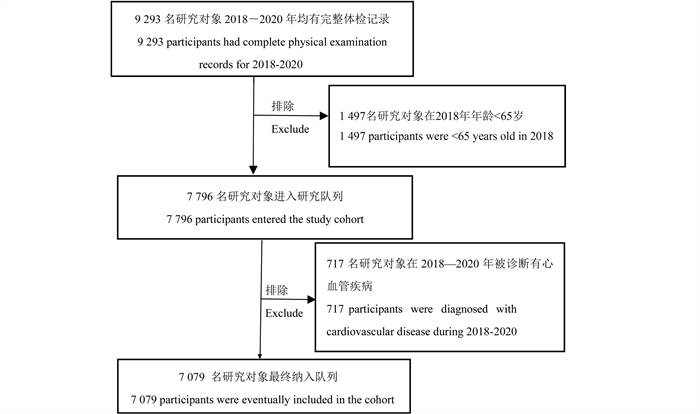Association between fasting blood glucose trajectories and new-onset cardiovascular diseases in the elderly health check-up population in Nanjing
-
摘要:
目的 探讨南京市老年人群(≥65岁)空腹血糖(fasting plasma glucose,FPG)轨迹和新发心血管病(cardiovascular disease,CVD)结局事件的关联。 方法 从南京市老年健康体检人群中选取符合纳入标准者作为研究对象,共计7 079人纳入研究队列,采用群组化轨迹模型(group-based trajectory modeling,GBTM)构建2018―2020年FPG指标(FPG取其对数使其服从正态分布)随年份变化的轨迹并分组,随访该人群2021年CVD的发病情况,应用Cox回归模型分析不同轨迹组和新发CVD的关联。 结果 该人群的FPG轨迹最终分为低水平组(5 635,79.6%)、中水平组(1 201,17.0%)和高水平组(243,3.4%)。随访期间共有CVD结局事件70例,其中低水平组、中水平组和高水平组新发病例数分别占该组人数的0.83%、1.42%、2.47%,发病率随着FPG轨迹水平升高而增加(趋势χ2 =8.750, P=0.003),差异有统计学意义(χ2 =9.050, P=0.011)。Cox回归模型分析结果显示,高水平组的CVD发病风险是低水平组的2.96倍(95% CI:1.27~6.92)。 结论 老年人群较高水平的FPG轨迹和较高的CVD发病风险相关,FPG值偏高会增加CVD的发病风险,应及时干预,以实现早期预防CVD的目的。 Abstract:Objective To investigate the association between fasting blood glucose trajectory and the incidence of cardiovascular disease among the elderly population aged 65 years and above in Nanjing. Methods A total of 7 079 participants were included from the Nanjing elderly health checkup cohort who met the inclusion criteria. The trajectory of fasting plasma glucose(FPG) index (FPG was taken as its logarithm to make it obey normal distribution) was constructed by group-based trajectory model (GBTM) over the years from 2018 to 2020. And we followed up the incidence of cardiovascular disease in 2021. A Cox regression model was used to analyze the association between distinct trajectory groups and the incidence of cardiovascular disease. Results The FPG trajectory was finally divided into low-level group (5 635, 79.6%), medium-level group (1 201, 17.0%) and high-level group (243, 3.4%). A total of 70 cases of cardiovascular disease were newly reported during the follow-up period, with the low, medium, and high level groups accounting for 0.83%, 1.42%, and 2.47% of the new cases in the group, respectively. The incidence of cardiovascular disease increased with increasing FPG levels (trend χ2 =8.750, P=0.003), and the difference was statistically significant (χ2 =9.050, P=0.011). The Cox regression model showed that the risk of cardiovascular disease in the high-level group was 2.96 times higher than that in the low-level group (95% CI: 1.27-6.92). Conclusions Long-term high levels of FPG increase the risk of cardiovascular disease in the elderly, so timely intervention and early prevention are warranted. -
Key words:
- Elderly population /
- Fasting plasma glucose /
- Trajectory /
- Cardiovascular disease /
- Cohort study
-
表 1 研究对象的基线资料特征
Table 1. Characteristics of baseline information on the participants
变量Variable 总人群①
Total population①
(n=7 079)变量Variable 总人群①
Total population①
(n=7 079)年龄/岁Age/years 71.07±4.88 吸烟Smoking 1 795(25.36) 年龄组/岁Age group/years 饮酒Drinking 1 833(25.89) 65-79 6 571(92.82) 体育锻炼Physical activity 794(11.22) ≥80 508(7.18) BMI/(kg·m-2) 24.71±3.44 性别Gender WC/cm 82.89±8.78 男Male 3 314(46.81) SBP/mmHg 144.40±20.03 女Female 3 765(53.19) DBP/mmHg 80.99±10.65 婚姻状况Marital status FPG/(mmol·L-1) 5.84±1.39 已婚Married 5 635(79.60) TC/(mmol·L-1) 5.06±0.97 未婚,离异或丧偶Divorced, widowed, or not married 1 444(20.40) TG/(mmol·L-1) 1.43±0.99 文化程度Education LDL-C/(mmol·L-1) 1.54±0.44 高中以下High school below 7 008(99.00) HDL-C/(mmol·L-1) 2.80±0.75 高中及以上High school and above 71(1.00) 注:WC,腰围;SBP,收缩压;DBP,舒张压;TC,总胆固醇;TG,三酰甘油;LDL-C,低密度脂蛋白胆固醇;HDL-C,高密度脂蛋白胆固醇。
①以人数(占比/%)或x±s表示。
Note: WC, waist circumference; SBP, systolic blood pressure; DBP, diastolic blood pressure; TC, total cholesterol; TG, triglycerides; LDL-C, low-density lipoprotein cholesterol; HDL-C, high-density lipoprotein cholesterol.
①Number of people (proportion/%) or x±s.表 2 空腹血糖指标对数值轨迹模型分组依据
Table 2. Basis for grouping of fasting blood glucose indicators into numerical trajectory models
分组数量Number of subgroups BIC 2△(BICij) 分组数量Number of subgroups BIC 2△(BICij) 1 21 456.37 (基线)(Baseline) 4 26 975.65 828.82 2 25 659.30 8 405.86 5 27 285.32 619.34 3 26 561.24 1 803.88 6 27 597.30 623.96 注:BIC,贝叶斯信息标准;2△(BICij),2个比较模型BIC差值的2倍,近似等于贝叶斯因子对数值。
Note: BIC, Bayesian information criterion; 2△(BICij), the value is approximately equal to 2 times of the difference of BIC between the 2 compared models, approximately equal to the value of Bayesian factor logarithm.表 3 不同轨迹组的相关参数
Table 3. Relevant parameters for different trajectory groups
分组
Groups参数
Parameters估计值
Estimatesx t值value P值value 低水平组Low-level group 截距Intercept 0.741 0.003 214.445 < 0.001 线性项Linear -0.017 0.004 -4.268 < 0.001 二次项Quadratic 0.004 0.001 3.974 < 0.001 中水平组Middle-level group 截距Intercept 0.871 0.008 103.662 < 0.001 线性项Linear -0.037 0.009 -4.079 < 0.001 二次项Quadratic 0.012 0.002 5.167 < 0.001 高水平组High-level group 截距Intercept 0.892 0.020 44.525 < 0.001 线性项Linear 0.120 0.025 4.752 < 0.001 二次项Quadratic -0.029 0.006 -4.584 < 0.001 表 4 不同空腹血糖轨迹组研究对象的基线资料
Table 4. Baseline information of participants among different fasting blood glucose trajectory groups
变量Variable 空腹血糖轨迹分组 ①
Fasting blood glucose trajectory groups ①χ2/F值value P值
value低水平组
Low-level group中水平组
Medium-level group高水平组
High-level group人数Number of population 5 635(79.60) 1 201(16.97) 243(3.43) 年龄/岁Age/years 71.11±4.94 70.86±4.65 71.23±4.58 1.408 0.245 性别Gender 53.798 < 0.001 女性Female 2 762(49.02) 461(38.38) 91(37.45) 男性Male 2 873(50.98) 740(61.62) 152(62.55) 婚姻状况Marital status 9.277 0.010 已婚Married 4 527(80.34) 920(76.60) 188(77.37) 未婚,离异或丧偶Divorced, widowed, or not married 1 108(19.66) 281(23.40) 55(22.63) 文化程度Education 4.329 0.363 高中以下High school below 5 582(99.06) 1 186(98.75) 240(98.77) 高中及以上High school and above 53(0.94) 15(1.25) 3(1.23) 吸烟Smoking 1 533(27.21) 219(18.23) 43(17.70) 51.680 < 0.001 饮酒Drinking 1 530(27.15) 260(21.65) 47(19.34) 22.058 < 0.001 体育锻炼Physical activity 593(10.52) 171(14.24) 30(12.35) 14.040 0.001 BMI/(kg·m-2) 24.41±3.40 25.87±3.31 25.92±3.62 108.152 < 0.001 WC/cm 82.07±8.68 86.06±8.99 86.47±9.29 123.369 < 0.001 SBP/mmHg 143.49±20.11 148.05±19.32 146.63±22.20 27.199 < 0.001 DBP/mmHg 80.71±10.93 81.86±9.98 82.72±10.74 8.969 < 0.001 FPG/(mmol·L-1) 5.49±8.45 7.18±1.30 9.99±2.99 60.948 < 0.001 TC/(mmol·L-1) 5.35±10.97 5.65±19.30 5.27±1.07 0.290 0.748 TG/(mmol·L-1) 1.37±1.24 1.73±1.31 1.98±2.41 58.231 < 0.001 LDL-C/(mmol·L-1) 2.87±4.99 2.86±0.75 2.94±0.80 0.030 0.970 HDL-C/(mmol·L-1) 1.66±4.11 1.44±0.42 1.45±0.37 1.997 0.136 新发CVD病例New cases of CVD 47(0.83) 17(1.42) 6(2.47) 9.050 0.011 注:WC,腰围;SBP,收缩压;DBP,舒张压;TC,总胆固醇;TG,三酰甘油;LDL-C,低密度脂蛋白胆固醇;HDL-C,高密度脂蛋白胆固醇; CVD, 心血管病。
①以人数(占比/%)或x±s表示。
Note: WC, waist circumference; SBP, systolic blood pressure; DBP, diastolic blood pressure; TC, total cholesterol; TG, triglycerides; LDL-C, low-density lipoprotein cholesterol; HDL-C, high-density lipoprotein cholesterol; CVD, cardiovascular disease.
①Number of people (proportion/%) or x±s.表 5 不同空腹血糖轨迹组发生心血管病的Cox回归分析
Table 5. Cox regression analysis of the occurrence of cardiovascular disease among different fasting blood glucose trajectory groups
模型Model 类别Category β值
valuesx Wald χ2
值valueHR值value
(95% CI)P值
value模型1 Model 1 低水平组Low-level group 1.000 中水平组Medium-level group 0.529 0.283 3.492 1.697(0.975~2.955) 0.062 高水平组High-level group 1.085 0.434 6.267 2.960(1.266~6.924) 0.012 模型2 Model 2 低水平组Low-level group 1.000 中水平组Medium-level group 0.488 0.284 2.944 1.629(0.933~2.845) 0.086 高水平组High-level group 1.020 0.434 5.516 2.774(1.184~6.501) 0.019 模型3 Model 3 低水平组Low-level group 1.000 中水平组Medium-level group 0.430 0.291 2.178 1.537(0.868~2.722) 0.140 高水平组High-level group 0.914 0.443 4.262 2.495(1.047~5.945) 0.039 注:模型1未经调整;模型2在模型1的基础上调整了年龄和性别;模型3在模型2的基础上调整了基线BMI、腰围、收缩压、舒张压、总胆固醇、三酰甘油、低密度脂蛋白胆固醇和高密度脂蛋白胆固醇指标平均值。
Note: Model 1 unadjusted; model 2 adjusting for age and gender based on model 1; Model 3 adjusting for baseline mean BMI, waist circumference, systolic blood pressure, diastolic blood pressure, total cholesterol, triglycerides, low-density lipoprotein cholesterol, high-density lipoprotein cholesterol. -
[1] 胡盛寿, 高润霖, 刘力生, 等. 《中国心血管病报告2018》概要[J]. 中国循环杂志, 2019, 34(3): 209-220. DOI: 10.3969/j.issn.1000-3614.2019.03.001.Hu SS, Gao RL, Liu LS, et al. Summary of the 2018 report on cardiovascular diseases in China[J]. Chin Circ J, 2019, 34(3): 209-220. DOI: 10.3969/j.issn.1000-3614.2019.03.001. [2] 中国心血管健康与疾病报告编写组. 中国心血管健康与疾病报告2021概要[J]. 中国循环杂志, 2022, 37(6): 553-578. DOI: 10.3969/j.issn.1000-3614.2022.06.001.The Writing Committee of the Report on Cardiovascular Health and Diseases in China. Summary of china cardiovascular health and disease report 2021[J]. Chin Circ J, 2022, 37(6): 553-578. DOI: 10.3969/j.issn.1000-3614.2022.06.001. [3] GBD 2019 Diseases and Injuries Collaborators. Global burden of 369 diseases and injuries in 204 countries and territories, 1990-2019: a systematic analysis for the Global Burden of Disease Study 2019[J]. Lancet, 2020, 396(10258): 1204-1222. DOI: 10.1016/S0140-6736(20)30925-9. [4] Zhao D, Liu J, Wang M, et al. Epidemiology of cardiovascular disease in China: current features and implications[J]. Nat Rev Cardiol, 2019, 16(4): 203-212. DOI: 10.1038/s41569-018-0119-4. [5] Roth GA, Mensah GA, Johnson CO, et al. Global burden of cardiovascular diseases and risk factors, 1990-2019: update from the GBD 2019 study[J]. J Am Coll Cardiol, 2020, 76(25): 2982-3021. DOI: 10.1016/j.jacc.2020.11.010. [6] Teo KK, Rafiq T. Cardiovascular risk factors and prevention: a perspective from developing countries[J]. Can J Cardiol, 2021, 37(5): 733-743. DOI: 10.1016/j.cjca.2021.02.009. [7] Liu S, Li Y, Zeng X, et al. Burden of cardiovascular diseases in China, 1990-2016: findings from the 2016 global burden of disease study[J]. JAMA Cardiol, 2019, 4(4): 342-352. DOI: 10.1001/jamacardio.2019.0295. [8] Goldsborough E 3rd, Osuji N, Blaha MJ. Assessment of cardiovascular disease risk: a 2022 update[J]. Endocrinol Metab Clin North Am, 2022, 51(3): 483-509. DOI: 10.1016/j.ecl.2022.02.005. [9] Han C, Liu F, Yang X, et al. Ideal cardiovascular health and incidence of atherosclerotic cardiovascular disease among Chinese adults: the China-PAR project[J]. Sci China Life Sci, 2018, 61(5): 504-514. DOI: 10.1007/s11427-018-9281-6. [10] 北京高血压防治协会, 北京糖尿病防治协会, 北京慢性病防治与健康教育研究会, 等. 基层心血管病综合管理实践指南2020[J]. 中国医学前沿杂志(电子版), 2020, 12(8): 1-73. https://www.cnki.com.cn/Article/CJFDTOTAL-YXQY202008002.htmBeijing Hypertension Association, Beijing Diabetes Prevention and Treatment Association, Beijing Research for Chronic Diseases Control and Health Education, et al. Practice guidelines for comprehensive management of primary cardiovascular disease 2020[J]. Chinese Journal of Frontiers in Medicine (Electronic Version), 2020, 12(8): 1-73. https://www.cnki.com.cn/Article/CJFDTOTAL-YXQY202008002.htm [11] Wang L, Peng W, Zhao Z, et al. Prevalence and treatment of diabetes in China, 2013-2018[J]. JAMA, 2021, 326(24): 2498-2506. DOI: 10.1001/jama.2021.22208. [12] Zang E, Max JT. Bayesian estimation and model selection in group-based trajectory models[J]. Psychol Methods, 2022, 27(3): 347-372. DOI: 10.1037/met0000359. [13] Benjamin EJ, Virani SS, Callaway CW, et al. American heart association council on epidemiology and prevention statistics committee and stroke statistics subcommittee. Heart disease and stroke statistics-2018 update: a report from the American heart association[J]. Circulation, 2018, 137: e67-e492. [14] 中国预防医学科学院, 中国吸烟与健康协会, 卫生部疾病控制司, 等. 1996年全国吸烟行为的流行病学调查[M]. 北京: 中国科学技术出版社, 1997: 155-158. [15] Jones BL, Nagin D, Roeder K. A SAS procedure based on mixture models for estimating developmental trajectories[J]. Sociol Methods Res, 2001, 29(3): 374-393. DOI: 10.1177/0049124101029003005. [16] Nina V, Mendes AG, Sevdalis N, et al. Applicability of the disruptions in surgery index in the cardiovascular management scenarios - a marker for developing functionally efficient teams[J]. Braz J Cardiovasc Surg, 2021, 36(4): 445-452. DOI: 10.21470/1678-9741-2020-0685. [17] 徐文华, 刘晋, 王增武, 等. 江苏省成年人高血压患病现状及影响因素分析[J]. 中国心血管病研究, 2020, 18(9): 775-782. DOI: 10.3969/j.issn.1672-5301.2020.09.002.Xu WH, Liu J, Wang ZW, et al. Analysis of the current prevalence and influencing factors of hypertension among adults in Jiangsu Province[J]. Chin J Cardiovasc Res, 2020, 18(9): 775-782. DOI: 10.3969/j.issn.1672-5301.2020.09.002. [18] Falkner B, Gidding S. Life-course implications of pediatric risk factors for cardiovascular disease[J]. Can J Cardiol, 2021, 37(5): 766-775. DOI: 10.1016/j.cjca.2021.02.001. [19] Francula-Zaninovic S, Nola IA. Management of measurable variable cardiovascular disease' risk factors[J]. Curr Cardiol Rev, 2018, 14(3): 153-163. DOI: 10.2174/1573403X14666180222102312. [20] Arnett DK, Blumenthal RS, Albert MA, et al. 2019 ACC/AHA guideline on the primary prevention of cardiovascular disease: a report of the american college of cardiology/american heart association task force on clinical practice guidelines[J]. Circulation, 2019, 140(11): e596-e646. DOI: 10.1161/CIR.0000000000000678. [21] Li Y, Teng D, Shi X, et al. Prevalence of diabetes recorded in mainland China using 2018 diagnostic criteria from the American diabetes association: national cross sectional study[J]. BMJ, 2020, 369: m997. DOI: 10.1136/bmj.m997. [22] 赵越, 张梅, 李伟, 等. 血糖控制不佳的2型糖尿病患者心血管病风险分析[J]. 心血管病学进展, 2020, 41(5): 551-555. DOI: 10.16806/j.cnki.issn.1004-3934.2020.05.026.Zhao Y, Zhang M, Li W, et al. Analysis of cardiovascular disease risk in patients with type 2 diabetes mellitus with poor glycemic control[J]. Adv Cardiovasc Dis, 2020, 41(5): 551-555. DOI: 10.16806/j.cnki.issn.1004-3934.2020.05.026. [23] Xu Y, Bi Y, Li M, et al. Significant coronary stenosis in asymptomatic Chinese with different glycemic status[J]. Diabetes Care, 2013, 36(6): 1687-1694. DOI: 10.2337/dc12-0977. [24] 冯国双, 于石成, 刘世炜. 轨迹分析模型在追踪数据分析中的应用[J]. 中国预防医学杂志, 2014, 15(3): 292-295. https://www.cnki.com.cn/Article/CJFDTOTAL-ZGYC201403036.htmFeng GS, Yu SC, Liu SW. Application of trajectory analysis model in tracking data analysis[J]. Chin Prev Med, 2014, 15(3): 292-295. https://www.cnki.com.cn/Article/CJFDTOTAL-ZGYC201403036.htm [25] 雷芳, 宋桂荣, 刘启贵, 等. 潜变量增长混合模型在学龄儿童体质指数变化轨迹分析中的应用[J]. 中国卫生统计, 2021, 38(4): 519-522, 527. DOI: 10.3969/j.issn.1002-3674.2021.04.009.Lei F, Song GR, Liu QG, et al. Application of latent variable growth mixed model in the analysis of trajectory of change in body mass index of school-aged children[J]. Chinese Journal of Health Statistics, 2021, 38(4): 519-522, 527. DOI: 10.3969/j.issn.1002-3674.2021.04.009. [26] 喻嘉宏, 陈小娜, 郜艳晖, 等. 潜变量增长混合模型在医学研究中的应用[J]. 中国卫生统计, 2018, 35(4): 496-499. DOI: 10.3969/j.issn.1671-3710.2007.03.023.Yu JH, Chen XN, Gao YH, et al. Application of latent variable growth mixture model in medical research[J]. Chinese Journal of Health Statistics, 2018, 35(4): 496-499, DOI: 10.3969/j.issn.1671-3710.2007.03.023. [27] Kim BJ, Cho YJ, Hong KS, et al. Trajectory groups of 24-hour systolic blood pressure after acute ischemic stroke and recurrent vascular events[J]. Stroke, 2018, 49(8): 1836-1842. DOI: 10.1161/STROKEAHA.118.021117. [28] Lennon H, Kelly S, Sperrin M, et al. Framework to construct and interpret latent class trajectory modelling[J]. BMJ Open, 2018, 8(7): e020683. DOI: 10.1136/bmjopen-2017-020683. [29] 王燕逍翔, 白建军, 宇传华. 基于全球视角的中国心血管病疾病负担现状及趋势[J]. 公共卫生与预防医学, 2021, 32(6): 6-11. DOI: 10.3969/j.issn.1006-2483.2021.06.002.Wang YYX, Bai JJ, Yu CH. Current status and trends of cardiovascular disease burden in China based on a global perspective[J]. J Public Health Prev Med, 2021, 32(6): 6-11. DOI: 10.3969/j.issn.1006-2483.2021.06.002. [30] Teo KK, Rafiq T. Cardiovascular risk factors and prevention: a perspective from developing countries[J]. Can J Cardiol, 2021, 37(5): 733-743. DOI: 10.1016/j.cjca.2021.02.009. [31] Li JJ, Liu HH, Li S. Landscape of cardiometabolic risk factors in Chinese population: a narrative review[J]. Cardiovasc Diabetol, 2022, 21(1): 113. DOI: 10.1186/s12933-022-01551-3. -





 下载:
下载:


